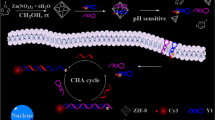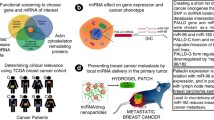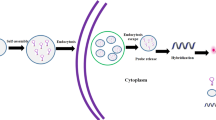Abstract
Purpose
The development of tools for the analysis of microRNA (miRNA) function in tumors can advance our diagnostic and prognostic capabilities. Here, we describe the development of technology for the profiling of miRNA expression in the tumors of live animals.
Procedures
The approach is based on miRNA nanosensors consisting of sensor oligonucleotides conjugated to magnetic nanoparticles for systemic delivery. Feasibility was demonstrated for the detection of miR-10b, implicated in epithelial to mesenchymal transition and the development of metastasis. The miR-10b nanosensor was tested in vivo in two mouse models of cancer. In the first model, mice were implanted subcutaneously with MDA-MB-231-luc-D3H2LN tumors, in which miR-10b was inhibited. In the second model, mice were implanted bilaterally with metastatic MDA-MB-231 and nonmetastatic MCF-7 cells. The nanosensors were injected intravenously, and fluorescence intensity in the tumors was monitored over time.
Results
We showed that the described nanosensors are capable of discriminating between tumors based on their expression of miR-10b. Radiant efficiency was higher in the miR-10b-active tumors than in the miR-10b-inhibited tumors and in the MDA-MB-231 tumors relative to the MCF-7 tumors.
Conclusions
The described technology provides an important tool that could be used to answer questions about microRNA function in cancer.




Similar content being viewed by others
References
Ling H, Fabbri M, Calin GA (2013) MicroRNAs and other non-coding RNAs as targets for anticancer drug development. Nat Rev Drug Discov 12:847–865
Yoo B, Kavishwar A, Ghosh SK et al (2014) Detection of miRNA expression in intact cells using activatable sensor oligonucleotides. Chem Biol 21:199–204
Bracken CP, Szubert JM, Mercer TR et al (2011) Global analysis of the mammalian RNA degradome reveals widespread miRNA-dependent and miRNA-independent endonucleolytic cleavage. Nucleic Acids Res 39:5658–5668
Pohlmann C, Sprinzl M (2010) Electrochemical detection of microRNAs via gap hybridization assay. Anal Chem 82:4434–4440
Song R, Ro S, Yan W (2010) In situ hybridization detection of microRNAs. Methods Mol Biol 629:287–294
Li W, Zhao B, Jin Y, Ruan K (2010) Development of a low-cost detection method for miRNA microarray. Acta Biochim Biophys Sin (Shanghai) 42:296–301
Husale S, Persson HH, Sahin O (2009) DNA nanomechanics allows direct digital detection of complementary DNA and microRNA targets. Nature 462:1075–1078
Mandir JB, Lockett MR, Phillips MF et al (2009) Rapid determination of RNA accessible sites by surface plasmon resonance detection of hybridization to DNA arrays. Anal Chem 81:8949–8956
Driskell JD, Primera-Pedrozo OM, Dluhy RA et al (2009) Quantitative surface-enhanced Raman spectroscopy based analysis of microRNA mixtures. Appl Spectrosc 63:1107–1114
Havelda Z (2010) In situ detection of miRNAs using LNA probes. Methods Mol Biol 592:127–136
Lu J, Tsourkas A (2009) Imaging individual microRNAs in single mammalian cells in situ. Nucleic Acids Res 37:e100
Nuovo GJ, Elton TS, Nana-Sinkam P et al (2009) A methodology for the combined in situ analyses of the precursor and mature forms of microRNAs and correlation with their putative targets. Nat Protoc 4:107–115
Silahtaroglu AN, Nolting D, Dyrskjot L et al (2007) Detection of microRNAs in frozen tissue sections by fluorescence in situ hybridization using locked nucleic acid probes and tyramide signal amplification. Nat Protoc 2:2520–2528
Nelson PT, Baldwin DA, Scearce LM et al (2004) Microarray-based, high-throughput gene expression profiling of microRNAs. Nat Methods 1:155–161
Moore A, Weissleder R, Bogdanov A Jr (1997) Uptake of dextran-coated monocrystalline iron oxides in tumor cells and macrophages. J Magn Reson Imaging 7:1140–1145
Fabian MR, Sonenberg N (2012) The mechanics of miRNA-mediated gene silencing: a look under the hood of miRISC. Nat Struct Mol Biol 19:586–593
van Rooij E, Kauppinen S (2014) Development of microRNA therapeutics is coming of age. EMBO Mol Med 6:851–864
Hartig JS, Grune I, Najafi-Shoushtari SH, Famulok M (2004) Sequence-specific detection of MicroRNAs by signal-amplifying ribozymes. J Am Chem Soc 126:722–723
Ko HY, Hwang W, Lee DS, Kim S (2009) A reporter gene imaging system for monitoring microRNA biogenesis. Nat Protoc 4:1663–1669
Cissell KA, Rahimi Y, Shrestha S et al (2008) Bioluminescence-based detection of microRNA, miR21 in breast cancer cells. Anal Chem 80:2319–2325
Tu Y, Li W, Wu P et al (2013) Fluorescence quenching of graphene oxide integrating with the site-specific cleavage of the endonuclease for sensitive and selective microRNA detection. Anal Chem 85:2536–2542
Yigit MV, Ghosh SK, Kumar M et al (2013) Context-dependent differences in miR-10b breast oncogenesis can be targeted for the prevention and arrest of lymph node metastasis. Oncogene 32:1530–1538
Ma L, Teruya-Feldstein J, Weinberg RA (2007) Tumour invasion and metastasis initiated by microRNA-10b in breast cancer. Nature 449:682–688
Ma L, Reinhardt F, Pan E et al (2010) Therapeutic silencing of miR-10b inhibits metastasis in a mouse mammary tumor model. Nat Biotechnol 28:341–347
Baffa R, Fassan M, Volinia S et al (2009) MicroRNA expression profiling of human metastatic cancers identifies cancer gene targets. J Pathol 219:214–221
Tromberg BJ, Pogue BW, Paulsen KD et al (2008) Assessing the future of diffuse optical imaging technologies for breast cancer management. Med Phys 35:2443–2451
Lee BT, Hutteman M, Gioux S et al (2010) The FLARE intraoperative near-infrared fluorescence imaging system: a first-in-human clinical trial in perforator flap breast reconstruction. Plast Reconstr Surg 126:1472–1481
Bhushan KR, Misra P, Liu F et al (2008) Detection of breast cancer microcalcifications using a dual-modality SPECT/NIR fluorescent probe. J Am Chem Soc 130:17648–17649
Yoo B, Ghosh SK, Kumar M et al (2014) Design of nanodrugs for miRNA targeting in tumor cells. J Biomed Nanotechnol 10:1114–1122
Medarova Z, Pham W, Farrar C et al (2007) In vivo imaging of siRNA delivery and silencing in tumors. Nat Med 13:372–377
Kumar M, Yigit M, Dai G et al (2010) Image-guided breast tumor therapy using a small interfering RNA nanodrug. Cancer Res 70:7553–7561
Wang J, Sui M, Fan W (2010) Nanoparticles for tumor targeted therapies and their pharmacokinetics. Curr Drug Metab 11:129–141
Akinc A, Thomas M, Klibanov AM, Langer R (2005) Exploring polyethylenimine-mediated DNA transfection and the proton sponge hypothesis. J Gene Med 7:657–663
Hong S, Leroueil PR, Majoros IJ et al (2007) The binding avidity of a nanoparticle-based multivalent targeted drug delivery platform. Chem Biol 14:107–115
Weissleder R, Kelly K, Sun EY et al (2005) Cell-specific targeting of nanoparticles by multivalent attachment of small molecules. Nat Biotechnol 23:1418–1423
Harisinghani MG, Barentsz J, Hahn PF et al (2003) Noninvasive detection of clinically occult lymph-node metastases in prostate cancer. N Engl J Med 348:2491–2499
Michel SC, Keller TM, Frohlich JM et al (2002) Preoperative breast cancer staging: MR imaging of the axilla with ultrasmall superparamagnetic iron oxide enhancement. Radiology 225:527–536
Chen W, Cai F, Zhang B et al (2013) The level of circulating miRNA-10b and miRNA-373 in detecting lymph node metastasis of breast cancer: potential biomarkers. Tumour Biol 34:455–462
Iyevleva AG, Kuligina E et al (2012) High level of miR-21, miR-10b, and miR-31 expression in bilateral vs. unilateral breast carcinomas. Breast Cancer Res Treat 131:1049–1059
Ouyang M, Li Y, Ye S et al (2014) MicroRNA profiling implies new markers of chemoresistance of triple-negative breast cancer. PLoS ONE 9:e96228
Acknowledgments
The authors would like to acknowledge the National Institutes of Health (R01CA16346101A1 from the National Cancer Institute to ZM and 5T32CA009502 to AM) and the Breast Cancer Alliance (Young Investigator Award to ZM) for funding support.
Funding
The study was supported under grants R01CA16346101A1 from the National Cancer Institute to ZM, the Young Investigator Award by the Breast Cancer Alliance to ZM, and 5T32CA009502 to AM.
Author information
Authors and Affiliations
Corresponding authors
Electronic supplementary material
Below is the link to the electronic supplementary material.
ESM 1
Supplemental Figure 1. Relative fluorescence intensity in miR-10b active and miR-10b inhibited MDA-MB-231 tumors at a early time points after nanosensor injection (0–3 h) and b late time points after nanosensor injection (3–24 h). (PDF 435 kb)
Supplemental Figure 2. Relative fluorescence intensity in MDA-MB-231 and MCF-7 tumors at a early time points after nanosensor injection (0–3 h) and b. late time points after nanosensor injection (3–40 h).
Rights and permissions
About this article
Cite this article
Yoo, B., Kavishwar, A., Ross, A. et al. In Vivo Detection of miRNA Expression in Tumors Using an Activatable Nanosensor. Mol Imaging Biol 18, 70–78 (2016). https://doi.org/10.1007/s11307-015-0863-3
Published:
Issue Date:
DOI: https://doi.org/10.1007/s11307-015-0863-3




